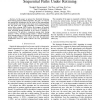56 search results - page 1 / 12 » Exploiting criticality to reduce bottlenecks in distributed ... |
HPCA
2011
IEEE
12 years 8 months ago
2011
IEEE
Composable multicore systems merge multiple independent cores for running sequential single-threaded workloads. The performance scalability of these systems, however, is limited d...
SPAA
2003
ACM
13 years 10 months ago
2003
ACM
Recent research on processor microarchitecture suggests using instruction criticality as a metric to guide hardware control policies. Fields et al. [3, 4] have proposed a directed...
ICS
2003
Tsinghua U.
13 years 10 months ago
2003
Tsinghua U.
Communication latencies within critical sections constitute a major bottleneck in some classes of emerging parallel workloads. In this paper, we argue for the use of Inferentially...
ASPDAC
2007
ACM
13 years 8 months ago
2007
ACM
Abstract-- In this paper we present the Statistical Retimingbased Timing Analysis (SRTA) algorithm. The goal is to compute the timing slack distribution for the nodes in the timing...
ACSC
2004
IEEE
13 years 8 months ago
2004
IEEE
When modern processors keep increasing the instruction window size and the issue width to exploit more instruction-level parallelism (ILP), the demand of larger physical register ...

